Part 3:
Still More Films by Edwin S. Porter of the Kinetoscope Era
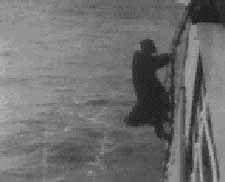 The surprisingly long travelogue comedy The European Rest Cure (1904) was an ambitious comedy starring Joseph Hart as a rube, the original "ugly American," who sets out on a sea journey in a tale crowded with incidents. Hart was a popular Vaudeville comic whose best known character "Foxy Grampa" was featured in Hart's other nine kinescope films
The surprisingly long travelogue comedy The European Rest Cure (1904) was an ambitious comedy starring Joseph Hart as a rube, the original "ugly American," who sets out on a sea journey in a tale crowded with incidents. Hart was a popular Vaudeville comic whose best known character "Foxy Grampa" was featured in Hart's other nine kinescope films
It mixes a bit of real footage to establish a realistic mood, then follows through with artfully designed sets. .
A middleaged overweight man, obviously a hick, kisses his family farewell & boards the ocean liner, with many a waving handkerchief or hat from dock to ship. The cinematography of the Hudson River & the New York city skyline strives for the expansive, capturing the beauty & drama of the passing world. Later footage, however, will not be locaton shots, the bulk of the film being comedy shtick on wonderfully designed stage sets.
Part of the film is serious enough to want to show the methods of running an ocean liner. A segment titled "Dropping the Pilot" shows the pilot climbing down from the ship to a rowboat, going ashore before the liner sets out of the bay into the Atlantic.
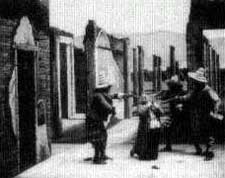 This is followed by "The Storm," shots of the prow rising & lowering as the ship drives into high waves. This is followed by "The Storm," shots of the prow rising & lowering as the ship drives into high waves.
Meanwhile in his room, our hero in his PJs is staggering about seasick trying to get in his bed, then hanging his head off the bed's edge over a basin. Water comes in at teh window making him think he's in the sea & he tries to swim.
"Kissing the Blarney Stone" finds our clownish hero atop castle walls in Ireland, a great set. A guide with a megaphone is addressing the crowd of tourists atop the wall. Three of the tourists help dangle our hero by his legs so he can kiss the blarney stone, but they accidently drop him.
I'm sure even then, most of the audience knew that wasn't even the place where you could kiss the blarney stone; but it was only for the joke.
"Going to Paris" finds our American hick in deerstalker cap conversing with lady tourists in an elegant cafe. He & the two gals jump up & do the can-can, while a Frenchman at a nearby table tries to ignore them.
"Climbing the Alps" has our hero & other tourists on a Meliesian set, very pretty, on a steep mountain trail, with walking staffs. Our hero takes a nasty tumble, his maps & tourist literature flying down the hillside.
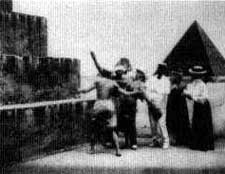 Our ugly American next experiences a "Hold Up in Italy" on another wonderfully designed set, a touristed ancient ruin seen at an angled perspective. Our ugly American next experiences a "Hold Up in Italy" on another wonderfully designed set, a touristed ancient ruin seen at an angled perspective.
The tourist guide leads the group through the ruins but our hero falls behind. Two bandits mug him, not the funniest of these episodes.
"Climbing the Pyramids of Egypt" is a simpler but very lovely set with a pyramid & sphinx on the painted backdrop, & the base of a stepped pyramid on the stage per se.
Our hick hero has finally ditched the deerstalker cap obtained in Ireland & is now wearing a pith helmet. Two turbaned Egyptians come down the side of the pyramid & insist he follow them upward, tugging on his arms until he has climbed out of sight.
The other characters exit stage left, & for a few moments (& it's a lot of time in kinetescopic terms) there is an empty set with nothing happening, nothing moving. Then, bam!, our hero comes tumbling down the pyramid, trick-photography used to make it look like a hardly landing.
What sort of trouble can he get himself into at "The Mudbaths of Germany"? In just his shorts he walks to where two men are offering him a bath. When he sees the tub is actually full of mud, he tries to escape, but they grab him, & in he goes.
They rub & scrub & dip him until he's black with mud. He looks totally miserable. The guys then hit him with bucket after bucket of cold water.
"Home Sweet Home" finds our "rested" & "cured" traveller needing practically to be carried to the brougham to be taken home.
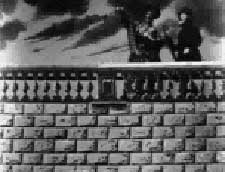 The trick-film Aunt Sallie's Wonderful Bustle (1901) has an appealing set, with the main action on a high wall, reminding me of the "Blarney Stone" episode in Edwin Porter's later comedy European Rest Cure. The trick-film Aunt Sallie's Wonderful Bustle (1901) has an appealing set, with the main action on a high wall, reminding me of the "Blarney Stone" episode in Edwin Porter's later comedy European Rest Cure.
Aunt Sallie & her whiskered husband are at some tourist site pointing & gawping from the railing atop the wall.
Sallie unexpectedly falls over the railing, but bounces on the ground & snaps right back to the top of the wall, hugging her husband with glad to have survived the close call.
Brief & minor as it is, the FX are wonderfully done, & the set so appealing, that there's undeniable art to this tiny gem.
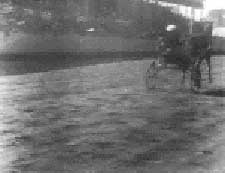 Another little travelogue comedy is A Rube Couple at a County Fair (1904). It's not as successful as The European Rest Cure because it focuses too little on the protagonistic couple & becomes much more a document of the fair events per se.
Another little travelogue comedy is A Rube Couple at a County Fair (1904). It's not as successful as The European Rest Cure because it focuses too little on the protagonistic couple & becomes much more a document of the fair events per se.
The country bumpkin couple had become standard in kinetoscopic cinema, & Porter used them to better effect in Aunt Sallie's Wonderful Bustle & in Rube & Mandy at Coney Island (1903), while Blackston used them to novel effect in The Mesmerist & the Country Couple (1899), with endless other examples that might be cited.
The setting is established by shots of cattle & horses on display at a county fair, paraded by handlers before a large crowd standing in the distant behind a wire fence. We next see events with horses on a race track.
In his Coney Island film, Porter had not made the error of having us wait so long to see the main characters. The rube couple finally arrive, first seen driving into the parking lot with their horse-drawn wagon, with a decided bumbling aspect as they give their wagon into the care of the lot attendant & run off excitedly toward the fair events.
The second half minimally documents their experiences at the county fair of Danbury, Connecticut, in October 1904. The events are given in documentary fashion more than as part of a comedy story & it's not as funny as it should have been.
It's mainly the rube couple's exaggerated walk & gawping & pointing that identifies them as comedic. But they vanish from the film not long after they're introduced, & it all ends with horse stunts & a circus act without further reference to Mr. & Mrs. Rube.
The ten scenes as described in the Edison catalog are in a different order than provided by the Library of Congress. Instead of arriving at the fairgrounds midway through the film, the catalog listed "Driving into the Grounds" as scene one. The cattle parade which is Scene One in the Library of Congress arrangement was cataloged as Scene VI.
It hardly matters, however, because the scenes were sold separately when first made, & could be shown in part or in whole in any order. And no matter the order, the rube couple are only in a small number of the scenes. A lot more character is squeezed out of Porter's Coney Island rubes, though they too exist to give perspective to documentary content.
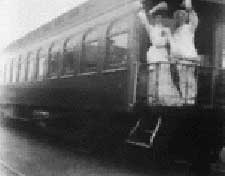 Yet another travel comedy is also a romantic comedy with middleclass characters not to be laughed at. A Romance of the Rail (1903) is a parody of travel advertising, but with such good location photography that it's also effective for the train travel footage through the Delaware Water Gap in the Blue Ridge Mountains.
Yet another travel comedy is also a romantic comedy with middleclass characters not to be laughed at. A Romance of the Rail (1903) is a parody of travel advertising, but with such good location photography that it's also effective for the train travel footage through the Delaware Water Gap in the Blue Ridge Mountains.
A man & woman meet at a train station. They're dressed in blazing white, which at the time was not regarded at all the right color for train travel due to soot from the steam locomotives.
In fact there had recently been an advertising campaign from the Lackawana Railroad in which a passenger named Phoebe Snow wears blinding white garments, claiming they never get the least bit sooty. A Romance of the Rail was a play off that campaign.
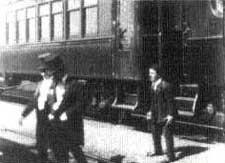 The Lackawana Railroad roles into the station, & our newly met couple board. Standing on the rear car, they wave farewell with their hankies; since there was no one else at the station, it is we, the audience, their waving acknowledges. The Lackawana Railroad roles into the station, & our newly met couple board. Standing on the rear car, they wave farewell with their hankies; since there was no one else at the station, it is we, the audience, their waving acknowledges.
They seat themselves on the rear car's little balcony to watch the countryside go by. They fall in love along the way, & at the Delaware Water Gap Station, they stand at the rear of the train as a preacher, in a blindingly white robe, gives them their marriage vows.
They continue on their way & arrive at their shared destination, where two tramps in travel-worn tuxedos & tophats climb out from under a passenger car. A porter with whisk broom wants to dust the soot off their tuxedos, for unlike our romantic couple who never did get sooty, riding underneath the train can be rather dirty. Their protest that they're not sooty is the joke's pay-off.
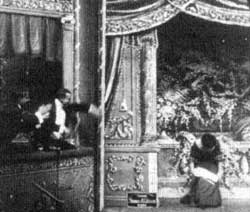 The inherent "peep show" nature of kinetoscope entertainment meant then pretty much what it sounds like. "Dirty" movies of the day may seem pretty innocent by today's standards, but in fact the kinetoscope parlors & carnival ground kinetoscope tents had a bad reputation, were frequently checked in on by the law, & had an ongoing clientelle for sleeze. The inherent "peep show" nature of kinetoscope entertainment meant then pretty much what it sounds like. "Dirty" movies of the day may seem pretty innocent by today's standards, but in fact the kinetoscope parlors & carnival ground kinetoscope tents had a bad reputation, were frequently checked in on by the law, & had an ongoing clientelle for sleeze.
Edison's company tried to counter this tendency by advertising photos & engravings of women peering in kinetoscopes, & by producing family-friendly mini-features like Porter's Buster Brown Series safe enough even for small boys. But the call for sleezier material was still always in the foreground, & profitability cannot be overlooked.
Of course, no one wanted to admit, "I'm going to the kinetoscope parlor to see a girly show." These were framed as comedies, A common set up was to show men sitting in a burlesque theater box getting all excited about the girl on the stage.
This made it possible to convince oneself that the interest was not the girl on the stage, but those silly men who wanted to see the girl on the stage. Without clownish rubes as point of view characters, then the fellow with his face pushed against the window of the kinetoscope would have to admit that he was the rube.
That's exactly the set up for more than one of Porter's films, including Uncle Josh at the Motion Picture Show (1902) & Two Chappies in a Box (1903).
The chappies are in the theater box getting drunk, & some critics have seen their wine bottle as a phallic symbol, though I have trouble believing Porter or any other filmmaker of the time had any such thing in mind. The woman performing on the stage does make them spill the bottle, however, staining the curtain as President Clinton stained Monica's dress.
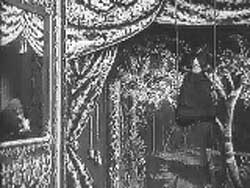 One of the best of this film type was Trapeze Disrobing Act (1901), thanks to the skill of the woman's act. One of the best of this film type was Trapeze Disrobing Act (1901), thanks to the skill of the woman's act.
The performer on the trapeze is believed to be Charmion, as it was certainly her act being portrayed. Charmian's act was much imitated in the burlesque houses, & Porter's trick-film The Mystic Swing (1900) also plays off this.
Trapeze Disrobing Act was produced by Porter & filmed by George S. Flemming, & it's really quite a good little film which transcends the seedy aspect while guarantee product for "those sorts" of gentlmen who were the bread & butter of a kinetoscope parlor.
The fellows in the theater box watch the elaborately decorated stage where a lady in a swing sits some distance in the air.
From her perch she begins to take off a few of her clothes, & does some trapeze moves in her petticoat. Whipping off a garter, she tosses it to the guys in the box, making them deliriously happy, or horny.
Then it's off with her stockings before she dangles upside down to take off the petticoat. Now wearing only a very revealing physical-culture two-piece she finishes her trapeze swinging.
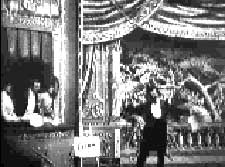 Porter can imagine the same burlesque staging with men & women together in the theater box, though for this sort of entertainment that hardly seems likely unless the girls are, ahem, available for a price.
Porter can imagine the same burlesque staging with men & women together in the theater box, though for this sort of entertainment that hardly seems likely unless the girls are, ahem, available for a price.
In The Extra Turn (1903) a man & two women in a theater booth watch a can-can dancer on the stage. The dancer is billed as Dolly Lightfoot. When she's finished, a tophat is thrown onto the stage (from the implied unseen audience behind the camera).
She picks the hat up, & exits with it stage right. What is unstated but would be known to the men viewing this vignette, the man who threw the hat would be permitted to reclaim it after the show, & quite conceivably claim more.
The second act is a male singer. Either he is very bad, or more likely the audience only came to see dancing girls. He's struck by several tophats thrown at him until he flees the stage, returning with an umbrella to protect himself as he struggles to finish his song. Finally the management drags him off the stage as he fights to get back on.
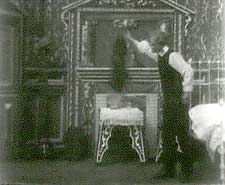 The title makes Catching an Early Train (1901) sound like it would be one of the "actuality" genre films that merely showed places or events without jest, drama, or story content. But really it's in the "trick film" category of comic special FX. The title makes Catching an Early Train (1901) sound like it would be one of the "actuality" genre films that merely showed places or events without jest, drama, or story content. But really it's in the "trick film" category of comic special FX.
The simple FX are obviously achieved by running film backward. In 1901 every trick was newly tried & remarkable. If viewed in the frame of mind of an Edwardian film-goer, Catching an Early Train is still funny more than a century later.
A man awakens realizing he has over slept. In the elegantly laid out bedroom, he leaps out of bed just about the full length of the room. His very clothes decide to help him hurry. His shoes, pants, shirt, all his clothes, including hat, satchel, & cane, jump into his arms item by item, & then he leaves, the title informs us, for the train.
copyright © by Paghat the Ratgirl
|
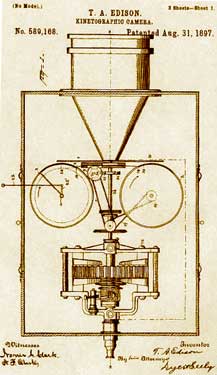

 This is followed by "The Storm," shots of the prow rising & lowering as the ship drives into high waves.
This is followed by "The Storm," shots of the prow rising & lowering as the ship drives into high waves.



 The Lackawana Railroad roles into the station, & our newly met couple board. Standing on the rear car, they wave farewell with their hankies; since there was no one else at the station, it is we, the audience, their waving acknowledges.
The Lackawana Railroad roles into the station, & our newly met couple board. Standing on the rear car, they wave farewell with their hankies; since there was no one else at the station, it is we, the audience, their waving acknowledges.


